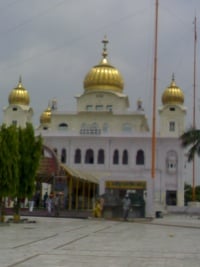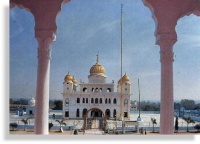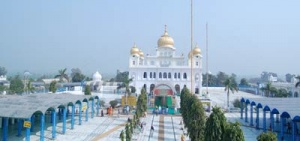Gurdwara Fatehgarh Sahib: Difference between revisions
No edit summary |
No edit summary |
||
| Line 6: | Line 6: | ||
|- | |- | ||
! Name : | ! Name : | ||
| | | Gurdwara Fatehgarh Sahib | ||
|- | |- | ||
! Place : | ! Place : | ||
| | | Distt. fatehgarh Sahib | ||
|- | |- | ||
! History: | ! History: | ||
| | | Younger Sahibzadas, Mata Gujri, Wazir Khan | ||
|- | |- | ||
|} | |||
'''Gurdwara Fatehgarh Sahib''', 5 km north of [[Sirhind]] (30°37'N, 76°23'E), marks the site of the execution of the two younger sons of [[Guru Gobind Singh]] at the behest of [[Wazir Khan]] of Kunjpura, the faujdar of Sirhind. | '''Gurdwara Fatehgarh Sahib''', 5 km north of [[Sirhind]] (30°37'N, 76°23'E), marks the site of the execution of the two younger sons of [[Guru Gobind Singh]] at the behest of [[Wazir Khan]] of Kunjpura, the faujdar of Sirhind. | ||
Revision as of 08:49, 2 September 2007
| Gurudwara Angitha Sahib | |
| Name : | Gurdwara Fatehgarh Sahib |
|---|---|
| Place : | Distt. fatehgarh Sahib |
| History: | Younger Sahibzadas, Mata Gujri, Wazir Khan |
Gurdwara Fatehgarh Sahib, 5 km north of Sirhind (30°37'N, 76°23'E), marks the site of the execution of the two younger sons of Guru Gobind Singh at the behest of Wazir Khan of Kunjpura, the faujdar of Sirhind.
History
As Guru Gobind Singh evacuated Anandpur on the night of 5-6 December 1705, he was closely pursued by the host. In front ran the Sarsa swollen with rain water. Under cover of a quick rearguard action fought on the banks of the stream, he succeeded in crossing it, but the members of his family got scattered in the tumult. Guru Gobind Singh's old mother, Mata Gujari, and her two grandsons, Zorawar Singh and Fateh Singh, aged 9 and 7 years respectively, had nowhere to go until their cook, named Gangu, offered to lake them to his own village Khen.
They accompanied him to his house. But he proved deceitful and betrayed them to Jam Khan and Man! Khan of Morinda. Tlie latter at once despatched them to Sirhind where they were consigned to the Cold Tower (Thanda Burj) of the Fort. On 9 December 1705, Zorawar Singh and Fateh Singh were produced before Wazir Khan, who had just returned from the battle of Chamkaur. Wazir Khan tried to lure them to embrace Islam with promises of riches and honours, but they spurned the offer. He threatened them with death as an alternative to Islam, but they remained firm.
A death sentence was eventually awarded. Nawab Sher Muhammad Khan of Malerkoila protested that it would be improper to harm the innocent children. Wazir Khan, however, ordered them to be bricked up alive in a wall, if they still refused conversion. They were kept in the Cold Tower in that severe winter for another two days. On 11 December, they, under the orders of Waxir Khan began to be paved with bricks standing on the ground. However, as the masonry reached above chest height, it crumbled. The next day, 12 December 1705, the Sahibzadas were once again offered the choice of conversion or death.
They chose the latter and fearlessly faced the executioner's sword. The cruelty of their murder and their fearlcssness of death which they preferred to giving up their faith finds a touching narration in "GarijiShahTdari" an Urdu poem by a Muslim poet, Allahyar Khan Jogi, who used to recite it from Sikh platforms during the second and third decades of the twentieth century. The aged Mata Gujari who had all along been confined in the Cold Tower, only a little distance away, breathed her last as the news reached her ears. The dead bodies were kept for the night at a spot now called Bimangarh, just outside the fort wall, and were cremated the following day by Seth Todar Mall, a wealthy merchant of Sirhind.
Sirhind suffered the full fury of Sikh ire when Banda Singh Bahadur marched upon it with his daring host. Wazir Khan was killed and the city was occupied on 14 May 1710. Diwan Suchchanand, who had explicitly championed the penalty laid upon the captives by the faujddr, was captured and tortured to death. The town, including the Fort, was razed to the ground. A memorial was raised marking the spot where the Sahibzadas were martyred and named Fatehgarh.
Sirhind, however, soon fell back into the hands of the Mughals and was later conquered by Ahmad Shah Durrani who appointed Zain Khan faujddr in 1761. As Zain Khan was finally defeated and killed in battle on January 1764 by the Dal Khalsa and as the Sikhs occupied the country around Sirhind, no Sikh Sardar was willing to keep the accursed town. It was consequently conferred upon Bhai Buddha Singh, a pious and humble Sikh. He later sold it to Baba Ala Singh, founder of the Patiala dynasty.
To honour the memory of the young martyrs, a gurdwara was constructed on the site of the old memorial and named Fatehgarh Sahib. Maharaja Karam Singh (1798-1845) of Paliala had the gurudwara rebuilt. He also gave Sirhind Nizamat (district) the name of Fateh Sahib. Other shrines were, in course established around the central Gurdwara over a century the management ( shrines at Fatehgarh Sahib remained in the hands of local priests. In 1906, a con consisting of custodians of the di shrines was formed.
In 1944, Paliala ment constituted an Interim Gurdwara and an Improvement Committ Gurdwaras Fatehgarh Sahib andJoti After the formation of the Patiala a Punjab Stales Union (PEPSU) inJu the Interim Board was amalgamated Dharam Arth (Religious Endow Board. Upon the unification of PEP East Punjab into a single state of the the gurdwdrds in PEPSU passed un control of ihc Shiromani Gu Parbandhak Committee. Renovate development originally planned by provemcnt Committee of 1944 were l hand in 1955-56.
The architectural design of the building is IndoMuslim, with its flai pyramidal construction over a squan ribbed lotus dome on top, mosaic fill a richly patterned ceiling, radiati cusped arches, and projecting win< stands on an extensive mound and coi the landscape for miles around. The storeyed edifice on a raised platform divan hall on the ground floor, with ment below and a central pavilion an on top. The basement called Bhor contains the old brick enclosure bel be the exact site of the execution Sahibzadas. The Guru Granth Sahit cd here with holy relics, hilt of a sw' a dagger and a rusteaten fragme doubleedged weapon. The divan had marble floor and an artistically pz ceiling with the Guru Granth Sahib s the centre in a gilded pdlaki, portab pied seal, on a marble platform. The inverted lotus at the apex of the dome at the pinnacle are covered with gold-plated sheets and have an umbrellashaped gold finial. So are the domes of the four kiosks one at each corner of the roof. The threcsioreyed gateway is topped by decorative canopied pavilions and a clocktower.
Gurdwaras In Main Compund
- Gurdwara Mata Gujri
- Gurdwara Shahid Ganj is a low square platform with a flagpost, in the northern part of the inner compound of the main Gurdwara. It marks the site of the cremation of Sikhs who laid down their lives at the time ofBanda Singh's conquest of Sirhind in 1710. This shrine, too, is attended by the Niharig Singhs.
Gurdwaras Around main Gurdwara
References
- 1. Tara Singh, Sri Gur Tirath Sangrahi Amritsar, n.d.
- 2. Thakar Singh, Giani, Sri Gurduare Darshan. Amritsar 1923
- 3. Padam, Piara Singh, Char Sahibzade. Patiala, 1988



